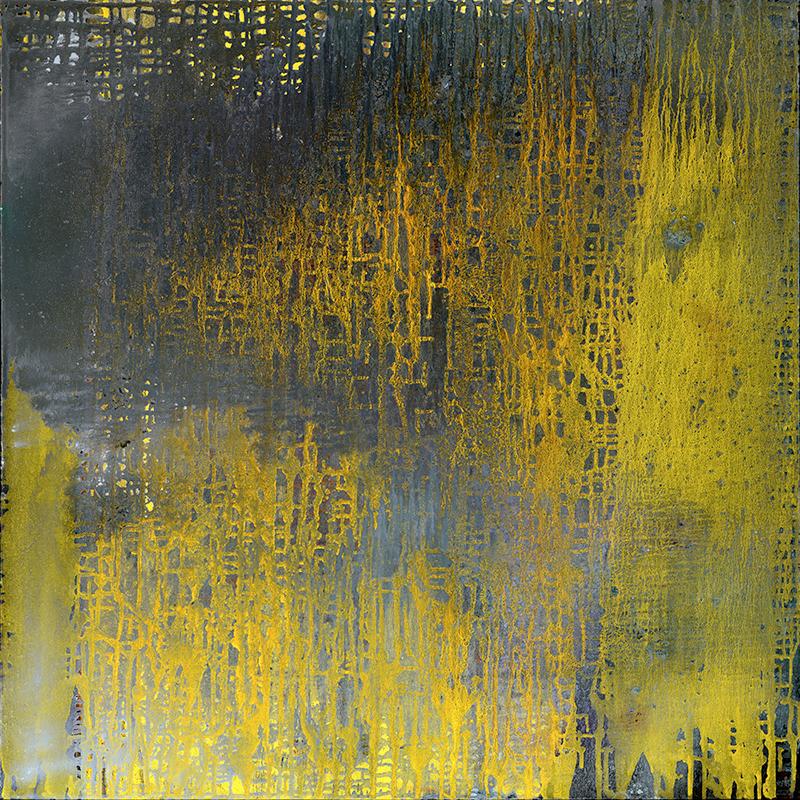DeWitt Cheng

The term Abstract Illusionism was used in the 1970s and 1980s to describe a kind of contemporary trompe-l’oeil, fool-the-eye paintings; realistic shading and pictorial space were employed for abstract expressionist paint blobs and drips, creating a kind of hybrid of abstract and realist art. I use the term here to suggest the dual nature of these works, hovering between abstraction and representation.
Yari Ostovany’s luminous abstractions, with their mists of colored vapor dispersed here and there by soft-edged vistas of paint drips running at right angles—the Cubist grid as orthogonal precipitation—may remind viewers of the charge leveled in the early nineteenth century at Turner’s effusions or even explosions of color, “paintings of nothing or very like.” Abstraction is now the orthodox style of a half century ago, but Ostovany’s free, experimental approach is irresistible, and gives the genre, which has had its facile practitioners, new life and immediacy—and numinous, transcendent meaning. If abstraction was once touted as a universal visual language, and then denounced as peculiarly individualistic (read: American), the Iranian-American Ostovany demonstrates that painting is a renewable resource, and that even a style that was marketed as pure painterliness, i.e., optics without representation or narrative, can serve ends other than the expression and exaltation of the self. Ostovany’s works, despite their links to Turner (as well as, say, second-generation AbExers like Helen Frankenthaler and Jules Olitski) refer to his home culture:
Chellehneshin is a compound word in Persian consisting of the words Chelleh; which describes a period of forty days; and Neshin, which literally means sitting. It refers to a seeker going into solitude for a period of forty days and forty nights to pray and meditate. In several mystical traditions, The Cycle of Forty is a common duration needed for spiritual metamorphosis and transitions to another, transcendent dimension.
Conference of the Birds is a Sufi fable by Farideddin Attar, a 12th-century Persian mystic. Attar’s verse focuses on a flock of birds that goes in search of a King, the Phoenix (Simorgh). After enduring hardships, doubt and exhaustion set It and most give up the quest. Simorgh through a slight alteration becomes Si-Morgh (thirty birds), however. The long-sought Phoenix Is those birds themselves who persevered.
Fragments of Poetry and Silence is inspired by a poem by the novelist and critic John Berger: “In a pocket of earth / I buried all the accents / of my mother tongue there they lie / like needles of pine / assembled by ants
one day the stumbling cry / of another wanderer / may set them alight then warm and comforted / he will hear all night / the truth as lullaby”
The Third Script is a reference to the 13-century sage, Shams-e-Tabrizi, who wrote: “The writing comes in three scripts. One that he alone can read. One that he and others can read. And one that neither he nor anyone else can read. I am that third script.” The inspiration and the point of departure for this series is the rapturous encounter between Rumi (13th century Persian Sufi mystic and poet) and the dervish Shams of Tabriz in November 1244. For Rumi this was an event set his soul on fire; it was Shams who freed the molten lava of poetry within him. Rumi and Shams found in each other the indescribable third script, which cannot be understood by mind but only known as its presence is felt.
Stanford, 2015
DeWitt Cheng is an artist, art writer, educator, and curator based in San Francisco.